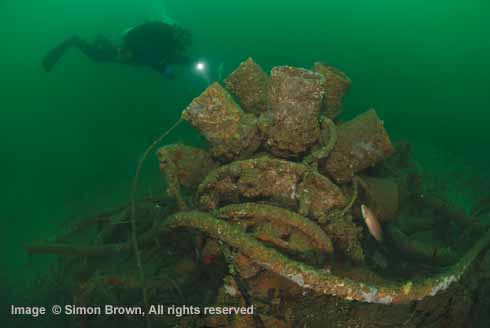Dorset from the sea – Double discovery
Simon Brown on the discovery of a World War 2 engine, which led to the discovery of what may be a Napoleonic-era merchantman
Published in November ’11
The Dorset coast plays host to hundreds of shipwrecks. Whilst the locations of many wrecks are known and often dived by scuba divers, there are many wrecks lying on the seabed that history has completely forgotten. Grahame Knott, skipper of the Weymouth-based Wey Chieftain, has set out to hunt down the missing, checking the historical records to pinpoint possible search areas and using the latest sonar equipment to scour the seabed to see what lies beneath the waves, but sometimes what the sonar reveals is not what it seems…
 For the previous six months a small team of divers assembled by Grahame had been investigating an aircraft crash site in the waters off Portland. Having found a single eighteen-cylinder radial engine and one undercarriage leg the team wondered where the rest of the P47 Thunderbolt aircraft lay, so Grahame scanned the surrounding seabed with sonar, turning up around 45 targets worthy of investigation. One target stood out; it was reasonably large and it was only 400 feet from the crash site. The first divers to reach the seabed realised the lump on the seabed pre-dated any aircraft. A mound of ballast stones were surrounded by iron cannon and anchors, hinting at the age of sail, not the age of flight. No one who saw the wreck for the first time knew exactly how old it was, but the consensus was anywhere between the 17th and 19th century, predating the aircraft by at least 100 years. A bottle found on the wreck was raised to help date the site.
For the previous six months a small team of divers assembled by Grahame had been investigating an aircraft crash site in the waters off Portland. Having found a single eighteen-cylinder radial engine and one undercarriage leg the team wondered where the rest of the P47 Thunderbolt aircraft lay, so Grahame scanned the surrounding seabed with sonar, turning up around 45 targets worthy of investigation. One target stood out; it was reasonably large and it was only 400 feet from the crash site. The first divers to reach the seabed realised the lump on the seabed pre-dated any aircraft. A mound of ballast stones were surrounded by iron cannon and anchors, hinting at the age of sail, not the age of flight. No one who saw the wreck for the first time knew exactly how old it was, but the consensus was anywhere between the 17th and 19th century, predating the aircraft by at least 100 years. A bottle found on the wreck was raised to help date the site.
Research into the anchor, cannon and the bottle has revealed a possible date range. The shape of the anchor dates the wreck to after 1800, and the fact that small cannon were on the ship indicates that it may be an armed merchantman. Cannon were generally removed after the end of the Napoleonic War to make way for more cargo, so the wreck may have sunk between 1800 and 1816. This is not conclusive, as the cannon may have been used as ballast. The bottle had the Ornans-based manufacturer’s name of ‘Cusenier’ embossed in the glass, and research indicates that it would have originally held French brandy. The company didn’t commence trading until 1868, so the bottle may be what archaeologists call an ‘intrusion’, and not contemporary with the ship. On subsequent dives no new evidence has been found, but the tail wheel of an aircraft has been found just 20 feet from the wreck site, another piece of the aircraft puzzle that adds another clue to identify the mysterious radial engine.
Much more detective work will be required to put a date to this ship with any degree of certainty, although work in the archives may be able to identify the name, cargo and original owner of the vessel. For those involved, solving a mystery like this is addictive and finding the wreck is just the beginning.



